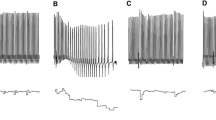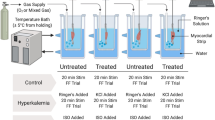Abstract
The importance of negative pericardial pressure to heart function in clasmobranchs has been questioned due to the discovery of positive pericardial pressures in healthy horn sharks (Heterodontus francisci). We therefore implanted electromagnetic flow probes on the ventral aorta of horn sharks and blue sharks (Prionace glauca) and assessed stroke volume and pericardial pressure as pericardial fluid volume (PFV) was varied to test the hypothesis that elasmobranchs are capable of maintaining a relatively large stroke volume at pericardial pressures near and above ambient. Stroke volume was maximum between zero and 25% maximum PFV (maximum PFV: the volume of pericardial fluid required to open the pericardioperitoneal canal), where pericardial pressure was most negative. At 50% maximum PFV (pericardial pressure near or slightly above ambient) stroke volume was 70% and 98% of its maximum in horn sharks and blue sharks, respectively. At a larger PFV, stroke volume declined drastically, reaching zero where both PFV and pericardial pressure were maximum. Thus, at a pericardial pressure apparently associated with resting or mild activity, stroke volume is a relatively large proportion of the apparent maximum. Increased circulatory demands associated with strenuous activity may induce ejection of pericardial fluid through the perieardioperitoneal canal, which then lowers pericardial pressure. The lowered pericardial pressure causes an increase in stroke volume, indicating that control is in part effected by changing pericardial pressure.
Similar content being viewed by others
References cited
Abel, D.C., Graham, J.B., Lowell, W.R., and Shabetai, R. 1986. Elasmobranch pericardial function. I. Pericardial pressures are not always negative. Fish Physiol. Biochem. 1: 75–83.
Castro, J.I. 1983. The Sharks of North American Waters. Texas A & M University Press, College Station.
Freadman, M.A. 1983. Pericardial cavity pressures in swimming fishes. Am. Zool. 23: 892.
Hanson, D. 1967. Cardiovascular dynamics and aspects of gas exchange in chondrichthyes. Ph.D. dissertation. University of Washington.
Johansen, K. 1965a. Cardiovascular dynamics in fishes, amphibians, and reptiles. Ann. N.Y. Acad. Sci. 127: 414–442.
Johansen, K. 1965b. Dynamics of venous return in elas. mobranch fishes. Hval. skr. 48: 94–100.
Nelson, D.R. and Johnson, R.H. 1970. Diel activity rhythms in the nocturnal, bottom-dwelling sharks,Heterodontus francisci andCephaloscyllium ventriosum. Copeia 1970: 732–739.
Peirce, E.C. II, Peiree E.M., and Peirce E.C. III. 1967. Effect of tricaine methanesulphonate (MS 222) on the circulation ofSqualus acanthias. Bull. Mt. Desert Is. Biol. Lab. 7: 45–47.
Satchell, G.H. 1971. Circulation in Fishes. Cambridge University Press, London.
Satchell, G.H. and Jones, M.P. 1967. The function of the conus arteriosus in the Port Jackson shark,Heterodontus portusjacksoni. J. Exp. Biol. 46: 373–382.
Satchell, G.H. and Maddalena, D.J. 1972. The cough or expulsion reflex in the Port Jackson shark,Heterodontus portusjacksoni. Comp. Biochem. Physiol. 41A: 49–62.
Shabetai, R., Abel, D.C., Graham, J.B., Bhargava, V., Keyes, R.S.,and Witztum, K. 1985. Function of the pericardium and pericardioperitoneal canal in clasmobranch fishes. Am. J. Physiol. 248: H198-H207.
Sudak, F.N. 1965. Some factors contributing to the development of subatmospheric pressure in the heart chambers and pericardial cavity ofMustelus canis (Mitchill). Comp. Biochem. Physiol. 15: 199–215.
Author information
Authors and Affiliations
Rights and permissions
About this article
Cite this article
Abel, D.C., Lowell, W.R., Graham, J.B. et al. Elasmobranch pericardial function 2. The influence of pericardial pressure on cardiac stroke volume in horn sharks and blue sharks. Fish Physiol Biochem 4, 5–14 (1987). https://doi.org/10.1007/BF02073861
Issue Date:
DOI: https://doi.org/10.1007/BF02073861




